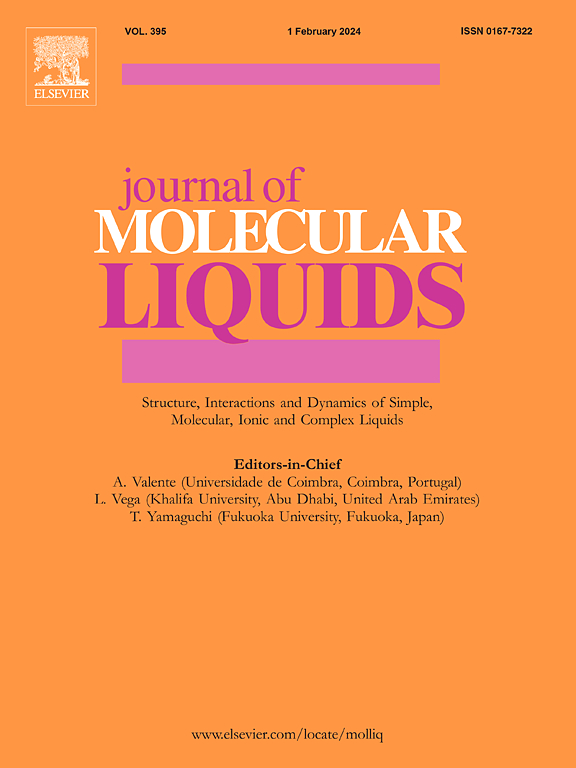A thermodynamic approach towards the phase separation phenomena and micellization of tetronic 701 and tetronic 90R4 in aqueous solutions
IF 5.3
2区 化学
Q2 CHEMISTRY, PHYSICAL
引用次数: 0
Abstract
Tetronics are X-shaped multi-stimuli responsive (pH- and temperature-sensitive) block copolymers made of poly ethylene oxide (PEO) and poly propylene oxide (PPO) blocks joined by a central ethylenediamine group. In this work, temperature and pH dependent micellization behaviour and phase separation phenomena have been studied with two Tetronics: Tetronic 701 having normal sequence and Tetronic 90R4 with a reverse sequence. The first one shows a single cloud point across all concentrations under investigation, whereas the second one shows double cloud points in the concentration range of 10–90 mM in acidic, normal and basic pH. In acidic pH, the core ethylene diamine group of both the copolymers remain in di-protonated structure, making them more hydrophilic, hence impeding the formation of micelles. The evaluation of the energetics of micellization and clouding phenomena have revealed that position of PPO and PEO w.r.t. central diamine moiety and the PPO/PEO content-ratio in Tetronics can affect these phenomena significantly. The enthalpy-entropy compensation plots for both processes are found to be linear. DLS has been used to evaluate the micellar diameters of the copolymers in the solution. A comprehensive analysis of the energetics behind the micellization and the clouding phenomena of Tetronics will facilitate their application in different fields.

双离子701和双离子90R4在水溶液中相分离现象和胶束化的热力学研究
Tetronics是一种x形多刺激响应(pH和温度敏感)嵌段共聚物,由聚环氧乙烷(PEO)和聚环氧丙烷(PPO)嵌段由中心乙二胺基团连接而成。本文研究了温度和pH值对胶束行为和相分离现象的影响,研究了正常序列的Tetronic 701和反向序列的Tetronic 90R4。第一种共聚物在所有研究浓度下均显示单个云点,而第二种共聚物在酸性、正常和碱性pH值的10-90 mM浓度范围内显示双云点。在酸性pH值下,两种共聚物的核心乙二胺基保持双质子化结构,使它们更亲水,从而阻碍了胶束的形成。对胶束和云现象的能量学评价表明,PPO和PEO的位置、中心二胺部分和PPO/PEO的含量比对这些现象有显著影响。两个过程的焓熵补偿图都是线性的。DLS用于评价溶液中共聚物的胶束直径。全面分析电子胶束化和云现象背后的能量学,将有助于其在不同领域的应用。
本文章由计算机程序翻译,如有差异,请以英文原文为准。
求助全文
约1分钟内获得全文
求助全文
来源期刊

Journal of Molecular Liquids
化学-物理:原子、分子和化学物理
CiteScore
10.30
自引率
16.70%
发文量
2597
审稿时长
78 days
期刊介绍:
The journal includes papers in the following areas:
– Simple organic liquids and mixtures
– Ionic liquids
– Surfactant solutions (including micelles and vesicles) and liquid interfaces
– Colloidal solutions and nanoparticles
– Thermotropic and lyotropic liquid crystals
– Ferrofluids
– Water, aqueous solutions and other hydrogen-bonded liquids
– Lubricants, polymer solutions and melts
– Molten metals and salts
– Phase transitions and critical phenomena in liquids and confined fluids
– Self assembly in complex liquids.– Biomolecules in solution
The emphasis is on the molecular (or microscopic) understanding of particular liquids or liquid systems, especially concerning structure, dynamics and intermolecular forces. The experimental techniques used may include:
– Conventional spectroscopy (mid-IR and far-IR, Raman, NMR, etc.)
– Non-linear optics and time resolved spectroscopy (psec, fsec, asec, ISRS, etc.)
– Light scattering (Rayleigh, Brillouin, PCS, etc.)
– Dielectric relaxation
– X-ray and neutron scattering and diffraction.
Experimental studies, computer simulations (MD or MC) and analytical theory will be considered for publication; papers just reporting experimental results that do not contribute to the understanding of the fundamentals of molecular and ionic liquids will not be accepted. Only papers of a non-routine nature and advancing the field will be considered for publication.
 求助内容:
求助内容: 应助结果提醒方式:
应助结果提醒方式:


